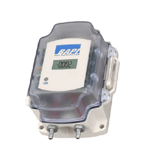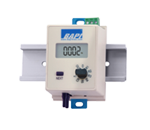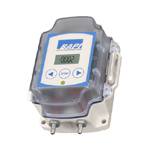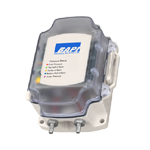1. Several manufacturers produce pressure transmitters, why should I purchase from BAPI?
2. BAPI makes several styles of pressure transmitters. What are the features of each?
3. What is “inches of water column?”
4. Why use inches of water?
5. What is differential pressure?
6. How is differential pressure measured?
7. What is burst pressure?
8. What is proof pressure?
9. What is bidirectional pressure?
10. What is Auto-Zero?
11. What is absolute pressure?
12. What is gauge pressure?
13. What is static pressure?
14. What is velocity pressure?
15. What is total pressure?
16. What does “temperature error” mean?
17. Are BAPI pressure transmitters able to withstand electrical interference, such as EMI/RFI, transient and ESD?
18. When I turn on my pressure transmitter, I get 2.5V on the analog output with zero applied pressure. Why?
19. What pressure measurement units are the transmitters calibrated to?
20. How often do BAPI pressure transmitters need to be recalibrated?
21. Are zero and span adjustments available on BAPI pressure transmitters?
22. What does “long-term stability” mean and how does it affect the measurements?
23. How do I know what pressure range to use?
24. Is National Institute of Standards and Technology traceability available for BAPI Transmitters?
25. May the published pressure and temp specifications for BAPI pressure transmitters be safely exceeded?
26. Why do you recommend that pressure transmitters be mounted with the ports down?
27. What does Bidirectional Pressure Measurement mean?
28. Can Differential Pressure Transmitters be used for measuring Suction Pressure?
29. What length of tubing may I attach to the transmitter’s pressure ports?
30. What if I need a pressure range that’s not in your catalog?
31. Will the pressure transmitter work properly if the supply voltage is slightly below the minimum specified level?
32. Where are BAPI’s products made?
33. How do I get more information?
1. Several manufacturers produce pressure transmitters, why should I purchase from BAPI?
BAPI manufactures high quality pressure transmitters at affordable prices. BAPI uses state of the art mono-crystalline silicon capacitive transducers. These transducers have very low inherent drift and imperceptible span shifts. BAPI’s computer controlled calibration equipment provides pressure transmitters with unsurpassed accuracy. Each transmitter comes with a free NIST traceable certificate of accuracy. If you ever misplace the certificate, BAPI can replace it when you provide us with the pressure transmitter’s serial number.
BAPI knows the difficulties that field technicians face when troubleshooting mechanical equipment malfunctions. BAPI’s pressure transmitters have displays that allow them to be used as test instruments. A simple glance will tell you if you are in or out of the calibrated range. BAPI manufactures a pressure transmitter for every air-side application.
ZPS (Zone Pressure Sensor) or BAPI-Box Pressure
The original ZPS was the industry’s first multi-range pressure transmitter. DIP switches allow the field technician to select one of 10 precision calibrated pressure ranges and one of 3 output ranges. Available in the BAPI-Box, the ZPS is the transmitter to carry on your service truck when you don’t know the exact pressure range or the mounting position you will encounter.
ZPS-EZ (EZ Mount Enclosure) or EZ Pressure
The ZPS-EZ is optimized for equipment or control panel mounting. 10 field selectable pressure ranges and 3 output ranges allow the flexibility to pick what’s needed for a particular application. It is available in the EZ mount enclosure for 2.75” snaptrack, 35 mm DIN rail, or mounting to any surface.
ZPT (Zone Pressure Touch) or Touch Pressure
The ZPT is the logical extension of the ZPS, with all the features of the ZPS and more. A touch button menu allows the field technician to select one of 20 precision calibrated pressure ranges, one of 5 output ranges, and set the endpoints of a custom pressure range. Available in the BAPI-Box®, the ZPT is the transmitter to carry on your service truck when you need a custom pressure range in a hurry.
FRP (Fixed Range Pressure)
The FRP is BAPI’s pressure transmitter for cost conscious applications. One pressure range and one output range are selected at time of order. A multi-color LED indicates the applied pressure. Custom pressure ranges are available with NCNR minimum quantity orders.
2. BAPI makes several styles of pressure transmitters. What are the features of each?

ZPS Features
• Field selectable pressure transmitter with 3 ranges for general pressure applications.
Low Range, 10 field selectable ranges between -1.00” and 1.00” W.C. or -250 and 250 Pa
Standard Range, 10 field selectable ranges between -5.00 and 5.00” W.C. or -1,250 and 1,250 Pa
High Range, 5 field selectable ranges between 0 and 30” W.C. or 0 and 7,400 Pa
• Three field selectable output ranges: 4 to 20 mA, 0 to 5 VDC, 0 to 10 VDC
• All ranges are field selectable with DIP switches
• Display and non-display models
• 4-Digit LCD display shows the entire operational pressure range regardless of the pressure range selected
• BAPI-Box enclosure (Screw to any surface)

ZPS-EZ Features
• Field selectable pressure transmitter with 2 ranges for control panel mounting.
Low Range, 10 field selectable ranges between -1.00” and 1.00” W.C. or -250 and 250 Pa
Standard Range, 10 field selectable ranges between -5.00 and 5.00” W.C. or -1,250 and 1,250 Pa
• Three field selectable output ranges: 4 to 20 mA, 0 to 5 VDC or 0 to 10 VDC
• All ranges are field selectable with a rotary switch, pushbutton and the display
• EZ mount enclosure: 2.75” snaptrack, 35 mm DIN rail or screw to any surface.
• 4-Digit LCD display shows the entire operational pressure range regardless of the pressure range selected
• Field option to disable display

ZPT Features
• Field selectable pressure transmitter with 2 ranges for general pressure applications.
Low Range, 10 field selectable ranges between -1.00” and 1.00” W.C. or -250 and 250 Pa
Standard Range, 10 field selectable ranges between -5.00 and 5.00” W.C. or -1,250 and 1,250 Pa
• All ranges are field selectable through the front panel with a touch interface and the display
• Field selectable pressure measurement units of Pascal or inches W.C.
• Field technician can create a custom pressure range for specific applications
• Custom range can have reverse acting output
• Five field selectable output ranges: 4 to 20 mA, 0 to 5 VDC, 1 to 5 VDC, 0 to 10 VDC or 2 to 10 VDC
• Field selectable output dampening: Fast = 0.05 second time constant | Slow – 0.5 second time constant
• BAPI Box enclosure (Screw to any surface)
• System diagnostics at the touch of a button
• Field option to disable display

FRP Features
• Pressure transmitter with one factory set pressure and one factory set output range for specific applications.
• Sixteen ranges between -5.00” W.C. and 5.00” W.C.
• Sixteen ranges between -1,250 Pa and 1,250 Pa
• Custom pressure ranges and output ranges are available with minimum quantity purchases required
• Custom pressure range can have reverse acting output
• A multiple color LED indicates pressure:
Red = over pressure | Green = top half of span | Amber = center of span
Blue = bottom half of span | Purple = Under pressure
• Four Voltage Output Ranges: 0 to 5 VDC, 1 to 5 VDC, 0 to 10 VDC, 2 to 10 VDC
• BAPI Box enclosure (Screw to any surface)
• Other mounting options are available, contact BAPI for details.
3. What is “inches of water column?”
An inch of water is the pressure exerted by a column of water one inch tall. There are 27.68 inches of water in one pound per square inch. Automobile tires at 32 psi pressure have a pressure of 885.76 inches of water.
4. Why use inches of water?
Air supply ducts typically work at pressures of 0.75 to 2.5 inches of water. It is easier to say 1 inch of water rather than 0.036 psi.
5. What is differential pressure?
Differential pressure is the pressure difference between two pressure sources.
6. How is differential pressure measured?
The output is the difference from the high pressure port to the low pressure port. For example, if the high pressure port is connect to a pressure of 10” of water and if the low pressure port is connected to a pressure of 8” of water, then the transmitter’s output is 2 inches of water.
7. What is burst pressure?
Burst pressure is the maximum pressure that may be applied to the sensor without destroying the sensor. If this happens a transmitter may need factory recalibration because the excess pressure may strain the sensors internal mounting. BAPI’s ZPS burst pressure is 1.5psi. To date, no ZPS unit has required factory recalibration when subjected to these pressures.
8. What is proof pressure?
Proof pressure is the maximum pressure that may be applied without changing the transducer performance. BAPI’s ZPS proof pressure is 1psi.
9. What is bidirectional pressure?
Bidirectional pressure refers to pressure values above and below the pressure on the negative pressure port. The output signal is at the center of the range at zero differential pressure.
10. What is Auto-Zero?
Auto-zero is the field calibration of the zero pressure output measurement.
11. What is absolute pressure?
Absolute pressure is the pressure measured relative to a perfect vacuum.
12. What is gauge pressure?
Gauge pressure is the differential pressure between the local ambient pressure and another pressure source.
13. What is static pressure?
Static pressure is the pressure on the walls of a vessel at right angle to any flow. Static pressure is usually measured with a static pressure probe.
14. What is velocity pressure?
Velocity pressure is the pressure caused by the momentum of moving air. Velocity pressure is usually measured with a Pitot tube assembly.
15. What is total pressure?
Total pressure is the arithmetic sum of static pressure and velocity pressure. Total pressure is usually measured with a total pressure tube.
16. What does “temperature error” mean?
Temperature error or “compensated temperature range” is an often misunderstood specification. This does not mean that there are no errors due to changing temperature, just that the errors are known, measured, and specified.
BAPI’s standard range pressure transmitters have the specification of 0.01% FS/°F (0.02% FS/°C) (±5.0” W.C. @ -4 to 140°F [-20 to 60°C]). This means that between -4 and 140°F, for every degree Fahrenheit away from 72°F, the output may shift from 0 up to ±0.01% of full scale. Below -4°F and above 140°F, the errors for BAPI pressure transmitters are not known.
17. Are BAPI pressure transmitters able to withstand electrical interference, such as EMI/RFI, transient and ESD?
Yes, all of BAPI’s pressure transmitters are certified to CE standards for electrostatic discharge, radiated susceptibility, electrical fast transient, surge, conducted immunity, voltage fluctuations, power frequency magnetic fields, and voltage dips.
18. When I turn on my pressure transmitter, I get 2.5V on the analog output with zero applied pressure. Why?
When BAPI pressure transmitters are in bidirectional mode they measure negative as well as positive pressure. The 0 to 5V analog output is divided to swing from 2.5 to 0 volts when operating with “negative” pressure and 2.5 to 5.0 volts when operating with “positive” pressure. Zero pressure is at one-half the output range.
19. What pressure measurement units are the transmitters calibrated to?
BAPI sells pressure transmitters calibrated in Inches of Water Column or Pascals. ZPS, ZPS-EZ, and FRP require either inches W.C. or Pascals to be specified at time of order. ZPT ships calibrated in both inches W.C. and Pascals and can be converted from inches W.C. to Pascals or back again in the field.
Conversion factors
27.68 in W.C. = 1 psi
249.09 Pa = 1.00 in W.C.
0.001 Bar = 100 Pa
20. How often do BAPI pressure transmitters need to be recalibrated?
For most applications performing an auto-zero whenever it appears that the transmitter has drifted is all that’s required. For critical applications, the unit should be tested and zeroed 2-3 times a year.
21. Are zero and span adjustments available on BAPI pressure transmitters?
Zero yes, span no.
All BAPI pressure transmitters have a simple auto-zero process. To auto-zero connect the transmitter’s high pressure port to the low pressure port with a short length of tubing. Press the auto zero button, flip the auto-zero switch, or select the Auto Zero menu, depending on model, and zero will be set in a few seconds. BAPI has had twelve pressure transmitters continuously powered since August 2008 and no identifiable shift in the span measurement has been revealed.
Even though we are confident in the long-term reliability of our pressure transmitters, BAPI recommends making periodic inspections to check for damage. BAPI’s technical service representatives will be happy to consult with you and make recommendations based on your requirements.
22. What does “long-term stability” mean? How does it affect the measurements?
Lack of long-term stability manifests itself as zero pressure drift. Drift is normally associated with aging of electronic components, adhesive creep of strain gauges, or relaxation over time of tensioned diaphragms. BAPI’s mono-crystalline silicon diaphragm is not tensioned and does not relax with age as metal diaphragms may do. BAPI’s capacitive pressure sensing transducers do not use strain gauges, so there is no possibility of creep.
23. How do I know what pressure range to use?
A pressure range of 1 ½ to 2 times the working pressure is generally selected.
24. Is National Institute of Standards and Technology traceability available for BAPI Transmitters?
Yes. BAPI’s instrumentation calibrations are traceable to NIST.
25. May the published pressure and temperature specifications for BAPI pressure transmitters be safely exceeded?
Pressures up to the specified proof pressure may be applied without damage. Temperatures up to the specified storage temperatures may be applied without damage. If the unit is powered, the temperature compensation error is undefined between -40°F to -4°F and 140°F to 203°F (-40°C to -20°C and 60°C to 95°C).
26. Why do you recommend that pressure transmitters be mounted with the ports down?
As long as an auto-zero is performed after installation, BAPI’s pressure transmitters may be mounted in any orientation. BAPI recommends that the ports face down so that any condensation that collects in the tubing may not enter the transmitter. It is good practice to leave “drip loops” in the tubing just before the transmitter.
27. What does Bidirectional Pressure Measurement mean?
The output signal is scaled over a pressure range which can vary with positive and negative pressures. For example; -1.00 in W.C. to +1.00 in W.C. = 0 to 10 Volts dc.
28. Can Differential Pressure Transmitters be used for measuring Suction Pressure?
Yes, if the pressure transmitter has a positive range higher than the suction pressure, connect the negative side port to the suction pressure and leave the positive port open to ambient air pressure.
29. What length of tubing may I attach to the transmitter’s pressure ports?
BAPI has tested the ZPS family with 1,000 feet of tubing attached to the transmitter’s positive pressure port and 1,000 feet of tubing attached to the negative pressure port simultaneously. No degradation in accuracy was detected. Response to pressure changes was slowed due to the length of tubing.
30. What if I need a pressure range that’s not in your catalog?
ZPS, ZPS-EZ, and ZPS-FRP transmitters may all be ordered with custom pressure ranges, contact your BAPI representative for details.
BAPI’s ZPT allows custom pressure ranges to be field selected. Please see the Installation & Operation instructions or contact your BAPI representative for details.
31. Will the pressure transmitter still work properly if the supply voltage is slightly below the minimum specified level?
BAPI does not recommend powering the pressure transmitter from power supplies lower than specified.
32. Where are BAPI’s products made?
Over 99% of BAPI’s products are made in Gay Mills, Wisconsin, USA. If you are in the area, please feel free to stop by for a visit!
See http://www.bapihvac.com/wp-content/uploads/2011/07/BAPI_Buy_American_Act.pdf for a full explanation.
If you would like more information, call your BAPI representative.



